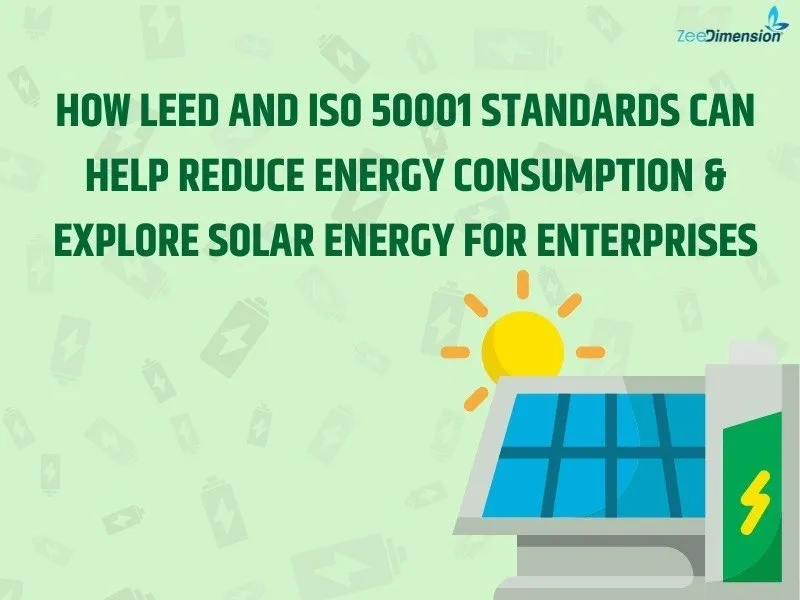
How LEED and ISO 50001 Standards Can Help?
Welcome to our blog! Businesses are under increasing pressure to adopt sustainable practices in the modern world. A comprehensive foundation for lowering energy usage is offered by two essential standards: ISO 50001 (Energy Management Systems) and LEED (Leadership in Energy and Environmental Design). Let’s explore how solar energy adoption and these requirements can provide meaningful, observable outcomes!
What is the difference between ISO 50001 and LEED?
ISO 50001 and LEED are both standards aimed at promoting sustainability, but they focus on different aspects and have distinct approaches:
• LEED: A globally recognized green building certification focusing on sustainable design, construction, and operation, emphasizing energy efficiency.
• ISO 50001: An international standard that helps organizations continuously monitor and improve energy performance.
Both frameworks provide structured ways to lower energy consumption and improve operational efficiency.
Reducing Energy Consumption with LEED & ISO 50001:
1- Energy Auditing & Monitoring:
LEED and ISO 50001 emphasize the importance of regular energy audits and continuous monitoring. This approach enables organizations to swiftly identify and mitigate energy wastage.
Example: A manufacturing facility successfully reduced its energy costs by 20% over three years by implementing ISO 50001’s continuous energy monitoring system.
2- Energy-Efficient Technologies in Action:
LEED promotes the use of energy-efficient HVAC systems, LED lighting, and smart automation to enhance building performance.
ISO 50001 incorporates energy management systems designed to optimize energy usage.
Example: A LEED-certified building can achieve up to a 35% reduction in energy consumption by implementing smart automation and energy-efficient lighting solutions.
Renewable Energy: LEED & ISO 50001 Focus on Solar Power
A key component of both the LEED and ISO 50001 standards is the incorporation of renewable energy, especially solar electricity. By reducing dependency on non-renewable resources, solar energy improves sustainability and lowers expenses. Significant cost savings are one advantage of integrating solar power since solar energy offers a free, renewable energy source that can significantly lower electricity bills. Furthermore, solar energy lessens dependency on fossil fuels, which lowers greenhouse gas emissions and promotes environmental cleanliness. By offering a dependable power source and lowering susceptibility to changes in energy prices and supply interruptions, solar energy systems help promote energy independence.
Case Study: Solar Energy for Corporate Headquarters
A corporate HQ in California consumes 500,000 kWh annually.
By installing a 350 kW solar system:
• The company generates 550,000 kWh annually.
• Annual savings: $80,000
• Over 25 years: $2 million in savings (excluding incentives).
Case Study: Solar Energy for Manufacturing Facilities
A manufacturing plant in Texas consumes 2 million kWh annually.
By installing a 1 MW solar system:
• It generates 1.5 million kWh annually, offsetting 75% of its energy needs.
• Annual savings: $180,000
• Over 25 years: $4.5 million in savings.
Cost & ROI of Solar Energy
The cost and return on investment (ROI) of solar energy are highly attractive. Installation costs typically range from $1 to $2 per watt, meaning a 350 kW solar system could cost between $350,000 and $700,000. The payback period for such an investment is generally between 4 to 6 years. Over the long term, solar energy offers significant savings and provides a sustainable energy source for the next 25+ years, making it a financially sound and environmentally friendly choice for businesses.
Key Takeaways: LEED, ISO 50001 & Solar Energy
1. An organized approach to energy efficiency is offered by LEED and ISO 50001.
2. Significant energy savings are achieved through the use of energy-efficient technologies and ongoing monitoring.
3. Using solar energy improves sustainability and has long-term financial advantages.
In conclusion :
Embracing LEED, ISO 50001, and solar energy can significantly enhance your business’s sustainability and energy efficiency. Begin your journey today and witness the transformative impact!







